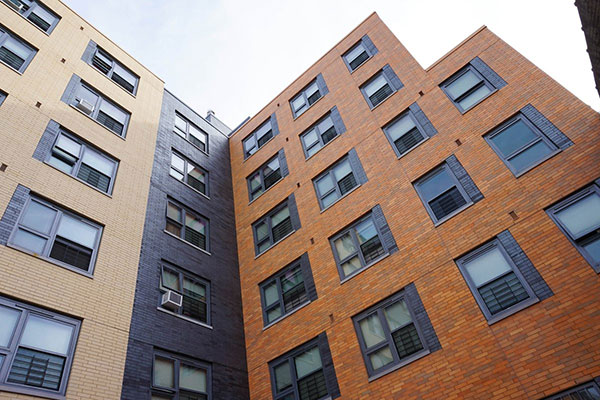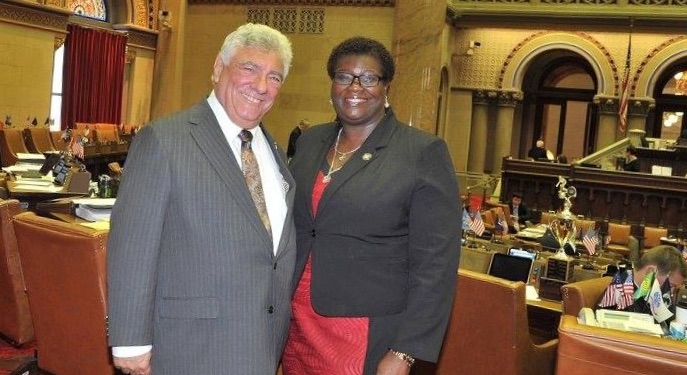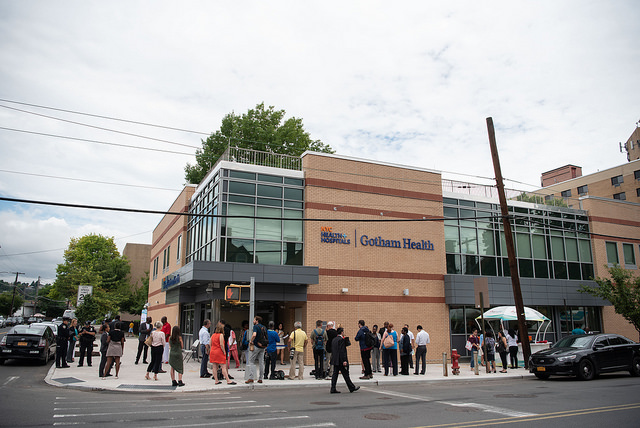Unlocking the Key to Real Affordable Housing in New York City

(photo: @NYCHousing)
Let’s say you’re a single mother of one child with an annual income of $45,000 looking for a two-bedroom apartment in Brooklyn. Off to a seemingly good start, you found a wonderful “affordable housing” unit, but the monthly rent is $2,700 with an annual salary requirement of $95,000. This is definitely out of reach, so you try to find a studio apartment and hope for the best. You find an “affordable” studio apartment, this time in Queens -- but you need at least a $75,000 salary for a monthly rent of $2,200. This isn’t affordable either. What gives?
One of Mayor Bill de Blasio’s main priorities, since taking office in 2014, is to build more affordable housing at a rate never seen before in New York City. Last year, the mayor announced his plan to boost production of affordable housing to 25,000 apartments annually by 2021, and set a new goal of 300,000 apartments by 2026. These terms and numbers, along with the language the mayor uses in celebrating his affordable housing achievements, give the perception that people will be able to stay in the neighborhoods they grew up in and halt displacement. But how “affordable” are these homes?
A simple look at New York City Housing Connect, the online portal to access applications for affordable housing, proves these homes are not as affordable and attainable as one may think.
Who’s to blame? Congress, in part.
Why are many of these apartments considered “affordable” if you need to make almost six figures to even apply? An especially vexing question given that the median income in New York City is roughly $33,000.
The short answer is “area median income,” also known as AMI, a statistic officially calculated by the U.S. Department of Housing and Urban Development (HUD). AMIs for New York City are calculated too high to begin with, and then the city sets “affordable rates” for many apartments well above AMI.
Some of New York City’s affordable housing in new constructions is targeted at income levels as high as 165% of the AMI, making it unattainable for low- or middle-income households. And AMI for the city is high on its own because it actually includes incomes from other counties outside of the city, those from individuals in Westchester, Rockland, and Putnam counties, all of which are home to higher average incomes. Thus, New York City’s AMI for 2018 is $93,900 for a family of three.
Why are these suburban counties included in an AMI for the region, rather than the five boroughs alone? HUD uses Metropolitan Statistical Areas (MSAs), which are based on commuting patterns determined by the federal government and often include counties far beyond an area’s urban core. Further, HUD has no formal mechanism for cities to challenge their AMI. New York’s AMI is 20 percent higher than actual median incomes in the city. This is flat out wrong and leads to New Yorkers being priced out of their homes and neighborhoods.
The very same apartments intended for low-income New Yorkers are being handed over to upper middle-class individuals and families. The city allocates millions of dollars for affordable housing projects, yet these projects are directed at the wrong people!
Some of this is by the mayor’s choice; de Blasio has decided to target more units at a broad range of affordability requirements than fewer units at lower rents.
But still, AMI is an essential component. Why can’t New York just change its AMI laws? Because AMI is determined through federal law and would require an act of Congress. Rep. Jose Serrano of the Bronx wrote a letter back in 2015 to then-HUD Secretary Julian Castro, expressing his support for a change in AMI calculation for New York City. However, Congress has not taken any action to actually mandate the reassessment of the city’s AMI.
Some have argued that changing AMI will make affordable housing development less financially viable and thus less appealing for developers to construct. The financing of affordable housing often depends on government subsidies to developers, though, so the equations are not simple ones. And, there are always questions about number of units versus depth of affordability. If AMIs were lowered to more accurately reflect need in New York City and make “affordable” apartments truly affordable to more tenants, some instances may call for a combination of developers accepting less profit and/or government offering more incentives.
There might be some hope for action in New York. Adjusting AMI may require congressional action, but that hasn’t stopped state elected officials from introducing legislation to address this issue. State Senator Michael Gianaris and Assembly Member Brian Barnwell, both Queens Democrats, have a bill pending in the state Legislature that would mandate developers calculate AMI based on ZIP code. It might not do much to reduce skyrocketing rents citywide, but this policy would definitely pave the way to a more affordable and transparent affordable housing system. The bill is still in committee, but considering the very real likelihood of a Democratic-controlled State Senate in January via the November elections, there might be a real chance for an overhaul of the current system and an outcome of meaningful change.
***
David Aronov is a graduate student at NYU’s Robert F. Wagner Graduate School of Public Service and Director of Community Relations for New York City Council Member Karen Koslowitz (the views expressed here are the author’s alone).
***
Have an op-ed idea or submission for Gotham Gazette? Email This email address is being protected from spambots. You need JavaScript enabled to view it.
In Brooklyn Democratic Party, Democracy is Healthier Than Some Would Have You Think

Frank Seddio & Senator Persaud (photo: Frank Seddio on Facebook)
Democracy in action can be messy, but the election law as well as state and local party rules are clear when it comes to how governments and political parties carry out their business. And despite the cathartic and frantic attempts by the New Kings Democrats to claim that party “bosses” thwarted their attempts to take over the Brooklyn Democratic County Committee, the fact is they did not have the votes.
They are focused on proxies, which allow elected committee members to have their voices heard if they cannot, for one reason or another, attend the semi-annual committee meeting. While the NKD complain that party leaders held the vast majority of proxies, their protestations fail to acknowledge that they worked very hard to collect proxies, mailing to everyone on the County Committee list seeking support for themselves. They failed.
Frank Seddio, the chair of the party’s Executive Committee, thanks to the hard work of many local clubs, received around 600 of those proxies from County Committee members who believed he would best represent their interests. The NKD, despite their best efforts, claimed they had 130.
I say “claimed” because those who complain the County Committee meeting started two-and-a-half hours late – implying there were some nefarious deeds going on behind the scenes to thwart democracy – know that the sole reason for the delay was because the NKD leaders failed to bring in their proxies at an appropriate time. They did not bring their proxies to the meeting hall until 90 minutes after the meeting was scheduled to start. Attorney volunteers had to sort them through a “bar-code system” that forced everyone in the hall to wait, but party leaders agreed to stipulate that they had 130 proxies so the meeting could start without waiting the additional two hours it might have taken to complete entry of the proxies into the system.
Even though many of the NKD proxies turned out to be invalid for a variety of required reasons, that did not change the fact that the party leadership stipulated and allowed the facially defective proxies to be counted. When combined with the votes of members in the room and the proxies each side held, the supporters of the current party leadership far outvoted those who wanted to seize control.
And since the County Committee is an entity whose activities in organizing the party’s structure and business is set out in state election law, failure to complete the committee’s business effectively would have put the party out of business, blocking it from nominating candidates to appear on the party’s line in elections.
The law is clear. A proxy is the voice of a “person,” someone who previously ran for a position on County Committee, but could not attend the meeting for reasons that could include health, work, family responsibilities, etc. I am amazed to hear that it is somehow undemocratic to allow their voices to be heard via his or her proxy, especially when the NKD worked so hard to gather proxies but apparently lack the support among party members to gather enough to alter the voting outcomes.
The NKD activists and leaders fail to mention that party leaders have acceded to virtually every one of their proposals for rules reform, and welcomed a proposal at the most recent County Committee meeting by Assemblymember Robert Carroll, a respected reformer, to change the proxy rules to require they be carried by another committee member from the same Assembly district. That will go to the rules committee for consideration, the same rules committee that approved every one of the reformers’ proposed changes last time they made them. Being open to ideas through robust discourse is not a novel idea. The district leaders have done just that for many years.
Nonetheless, for some it seems as it just feels better to simply not take yes for an answer, and instead to make up for their lack of broad support at the grassroots level by yelling, screaming, and disrupting the meeting.
We understand that Democratic politics has long been marked by factional family fights, a sign that, in the words of the chair, the party is “alive, exciting, and worth fighting over.” And we understand there is a generational challenge to party leadership, since many in the room started in politics as insurgents themselves challenging the party leadership at the time they entered the fight.
But there is an old lawyer expression that seems to apply here. When you have the facts on your side, pound the facts. When you have the law on your side, pound the law. When you have neither, pound the table.
Intra-party fights take place under the rules of the party, and that includes allowing proxies so Committee members who cannot attend have their voices represented. And make no mistake—it is a voice. That is why the NKD worked so hard to collect proxies, and why the party’s district leaders do so as well.
When they have enough votes to elect their chosen leaders, we will graciously respect the results and work with them to elect Democrats in order to push an agenda to benefit the people of Brooklyn, which is why we are all in this together in the first place.
From my perspective, we must continually work harder to reach everyone throughout every corner of the borough and in between, and remember we are all in this together.
***
Frank Carone, a partner in Brooklyn’s Abrams Fensterman law firm, is the law secretary of the Brooklyn Democratic Party.
***
Have an op-ed idea or submission for Gotham Gazette? Email This email address is being protected from spambots. You need JavaScript enabled to view it.
State of Latino Health: Dismal, and Invisible

(photo via NYC Mayor's Office)
Latinos make up nearly a third of New York City’s eight million residents. But even though we are a large part of New York’s present and a rising population that’s crucial to the city’s future, we are completely invisible.
We are invisible in large part because we are different. And because of those joined factors, our health care is in a state of crisis. Compared to our fellow New York neighbors, we lack access to quality, culturally competent care, and we face a shortage of high-quality family care options. In fact, we sometimes encounter unique barriers that make us even more susceptible to illnesses than our neighbors and tend to experience worse health outcomes.
After decades of efforts to bring health care to underserved Latinos across the city, we set out to answer crucial questions: Why do great disparities in health care remain? And why do our families lack the health care services they need?
Why are Latinos far less healthy than our neighbors?
In a new report put out by my organization, a nonprofit network of over 2,000 providers who treat over 650,000 patients largely from lower income immigrant communities, we talked to hundreds of Latino doctors and patients across New York City to compile a first-ever poll.
We hope it spurs a movement.
We set out to bring to light health disparities and the cultural, economic, and institutional barriers that diminish access to even basic health care services -- leading to devastating health outcomes for many in our communities.
So what did we learn about the state of Latino health in New York City in 2018?
First, we learned that there is a wide gap between Latino patients and their physicians over what constitutes good health. While a majority of Latinos think they are healthy, their doctors disagree by vast margins. And only one-third of Latino patients think they are not receiving the care they need while two-thirds of doctors think Latinos experience persistent barriers to care.
Second, transportation and child care pose major barriers to health care access in Latino communities. Language is another major issue: in the Bronx, home to the city’s largest Latino population, only 10% of doctors speak Spanish, compared to 60% of residents. In fact, immigrants interviewed stated that language barriers kept them from telling their health care providers all of their symptoms – leading to unnecessary emergency room visits, avoidable crises, and uncontrolled chronic conditions.
Finally, too many health problems are going untreated in the Latino community. Smoking, asthma, obesity, diabetes, and hypertension are prevalent problems but health education has not kept up and health education materials are often not available in Spanish. In addition, mental health and substance abuse challenges are stigmatized and remain taboo to discuss, going undertreated or even untreated.
In short, our report showed us that we have much more work to do to lift up and improve health outcomes in the Latino community, but we can make progress if we are willing to put in the work.
Together, by prioritizing community engagement, we can build and scale a sustainable architecture of innovation to confront and solve these problems. We can and must develop and sustain strong community, public health, and health care strategies to improve access to quality, culturally competent, and much needed care.
Additionally, we also need a serious investment in health education on the part of policy-makers to address not only these conditions but also the lack of health education resources offered. And language matters. Understanding these nuanced, culture-specific disparities will help us build a system that combines high quality with more effective care that reduces costs for patients, institutions, cities, states, and the federal government.
The Latino community is growing faster in New York than in Nevada or California. Over the next few years, through intervention, innovation, and integration, we will use the findings of this report to partner with the state and city to better deliver culturally-competent care and build a stronger, healthier Latino community in New York.
The need is urgent, the path forward clear – now it’s time for action.
***
Dr. Ramon Tallaj is the founder and chairman of SOMOS Community Care.
***
Have an op-ed idea or submission for Gotham Gazette? Email This email address is being protected from spambots. You need JavaScript enabled to view it.




